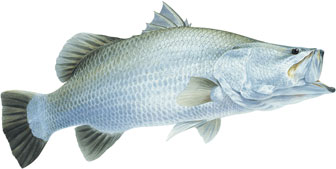
The barramundi is an icon of Western Australia’s Kimberley region, prized by recreational fishers for its taste, size and fighting spirit when hooked. In WA there is a significant commercial fishery for barramundi as well as aquaculture operations to produce stock. Barramundi live in both freshwater and saltwater and dominate many tropical rivers. They eat almost anything, including other barramundi, and can consume prey up to 60 per cent their own length. They can grow up to 200 cm in length and 60 kg. During their lifecycle, they change sex from male to female.
Barramundi belong to the sea perch family. They have a distinct pointed head, concave forehead, large jaw and rounded tail fin. They have a dorsal fin with seven or eight strong spines and a second dorsal fin of 10 or 11 rays. Freshwater barramundi are a greenish-blue on the upper body and have tail fins that are dark brown to black. Saltwater barramundi have a silvery body and yellow fins.
Distribution and habitat
Internationally, barramundi are known as Asian sea bass, giant perch or giant sea perch. They are distributed throughout coastal areas from the Persian Gulf to China and southern Japan, south to Papua New Guinea and northern Australia.
In Western Australia, they’re found north from Exmouth Gulf, but are most abundant in the Kimberley.
Barramundi can live in freshwater or saltwater. Habitats include streams, rivers, lakes, billabongs, estuaries and coastal waters.
Lifecycle
The barramundi’s lifecycle includes freshwater, estuarine and marine phases. In the wet season (October to April), sexually mature adults migrate from freshwater to coastal estuaries and river mouths to spawn (release sperm and eggs).
Spawning usually takes place after the full moon or new moon, when tidal activity is strongest.
A large female can produce up to 40 million eggs during the spawning season. Despite such high production, more than 90 per cent of larvae and juveniles die in the first few weeks or months.
Only 24 hours after fertilisation, the barramundi is almost ready to hatch from the egg. After hatching, the larvae are not yet fully developed. The eyes and mouth are closed and the larva relies on a supply of nutrients from the yolk sac, which is still attached to it.
High tides and wet season floods wash eggs and larvae into mangrove and tidal habitats. At day two or three of life, the eyes and mouth open and the larvae begin searching for food. The first live food they eat are plankton (microscopic plant and animal organisms that drift in clusters).
The larvae remain in the mangrove or tidal habitats until the end of the wet season.
The juvenile fish then migrate into rivers and freshwater billabongs, where they develop into adults over the course of three or four years. If they don’t have access to freshwater they stay in coastal and estuarine areas.
When the fish become sexually mature (at three to five years of age) they migrate back to the saltwater to spawn and the lifecycle begins again.
(Barramundi are protandrous hermaphrodites, meaning they change sex from male to female. They become sexually mature as males at about three to four years of age. Males turn into females from about five or six years of age, and about 80 cm in length, but require saltwater for this sex change.)
Diet
Juveniles eat small fish, aquatic insects and small crustaceans, such as prawns. Adults eat mainly fish, including other barramundi, and crustaceans.
Predators
Predators of barramundi include larger finfish, birds and large reptiles, such as the saltwater crocodile.
Barramundi also prey upon each other.
Illustration © R. Swainston/www.anima.net.au